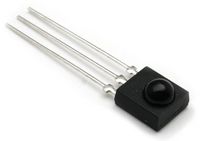Ryde remote controls
The Ryde DATV receiver is designed to work with an Infrared remote control handset.
Infrared sensor
A Infrared sensor is needed on the receiver and can be one salvaged from an old consumer electronic part or purchased new - typical example is https://uk.farnell.com/vishay/tsop2438/ir-receiver-45m-0-12mw-m2-side/dp/4913097
These sensors are 3 legged devices with +ve ground and output. The +ve should be connected to a 3.3v supply via a suitable resistor (typically 100 ohms) and the output is connected directly to pin 11 of the RPi GPIO port.
5 volt devices
Older devices may need to be used on a +5v supply and must be fitted with a resistor to ground on the high impedance output to reduce the voltage to 3.3v for the Rpi GPIO port.
Connect 5v to the device and use an oscilloscope to measure the voltage on the output - connect a 47K resistor to ground and check the level drops to 3.3v - if not adjust the resistor value to suit.
Remote control Handsets
The following remotes are already programmed in to the standard firmware:
- Virgin Media remote
- Nebula DigiTV DVB-T USB receiver
- Ebay DVB-T / DVB-S combo box
- LG 42 inch TV
- LG Blu-Ray Player
- Samsung 32 inch TV
- Elekta Bravo TV
- WDTV Live Media Player
- Hauppauge MediaMVP Network Media Player
- Technosat TS-1 Satellite Receiver
- Technosat TS-3500 Satellite Receiver
- Digi-Wav £2 F2100 Universal Remote
- Octagon SF8008 Sat RX Remote
- RTL-SDR Basic Remote
Photos of some of these remotes are on this page: Ryde Remote Photos
You can select the remote control by SSH in to the Ryde main menu > 3 Select the Remote Control Type.
Using a custom remote control
The Ryde receiver can be customised to use another suitable remote control - note not all remote controls will work.
You can program the Ryde to use a different type of remote. For software 202007200 and later:
First SSH into the Ryde and type Menu. Then go to option 6 IR Check. This takes you to the command line.
Next, press the following buttons on your remote control and note the code displayed against each button pressed.
You will need to create a new file "my_remote.yaml" that has the following format:
---
name: My Remote Name
driver: rc-5
buttons:
POWER: 0x0d
UP: 0x16
DOWN: 0x17
LEFT: 0x18
RIGHT: 0x19
SELECT: 0x1a
BACK: 0x14
MENU: 0x15
MUTE: 0x20
VOL+: 0x21
VOL-: 0x22
CHAN+: 0x23
CHAN-: 0x24
ZERO: 0x00
ONE: 0x01
TWO: 0x02
THREE: 0x03
FOUR: 0x04
FIVE: 0x05
SIX: 0x06
SEVEN: 0x07
EIGHT: 0x08
NINE: 0x09
Do not worry if your remote does not have number buttons. Menu, Up, Down, Left, Right and Select are sufficient to get started. Just delete the lines for the buttons that you don't have.
You also need to set the protocol that the remote uses in this file - you can see the protocol in the brackets when you press a key:
Testing events. Please, press CTRL-C to abort. 9801.580057: lirc protocol(rc5): scancode = 0x5 9801.580077: event type EV_MSC(0x04): scancode = 0x05 9801.580077: event type EV_SYN(0x00).
So in this example, the protocol is rc-5 and the code to enter in the file is 0x05.
You should save the file with a name such as my_remote.yaml in the /home/pi/RydeHandsets/definitions folder.
You then need to amend the file:
/home/pi/ryde/config.yaml
and enter the handset filename (without the .yaml) so that section of the file looks like:
ir:
repeatFirst: 200
repeatDelay: 100
repeatReset: 400
libraryPath: /home/pi/RydeHandsets/definitions
handsets:
- my_remote
gpio:
Once you have edited and saved both files, you can press ctrl-c to exit the remote control code monitor screen, and then type menu to return to the menu and then start the receiver. Test your remote.
If it all works, please post details of your remote and its codes on the BATC Forum here BATC Forum Ryde Remote Controls. The software team can then add the remote to the main build so that it is available to all users.
